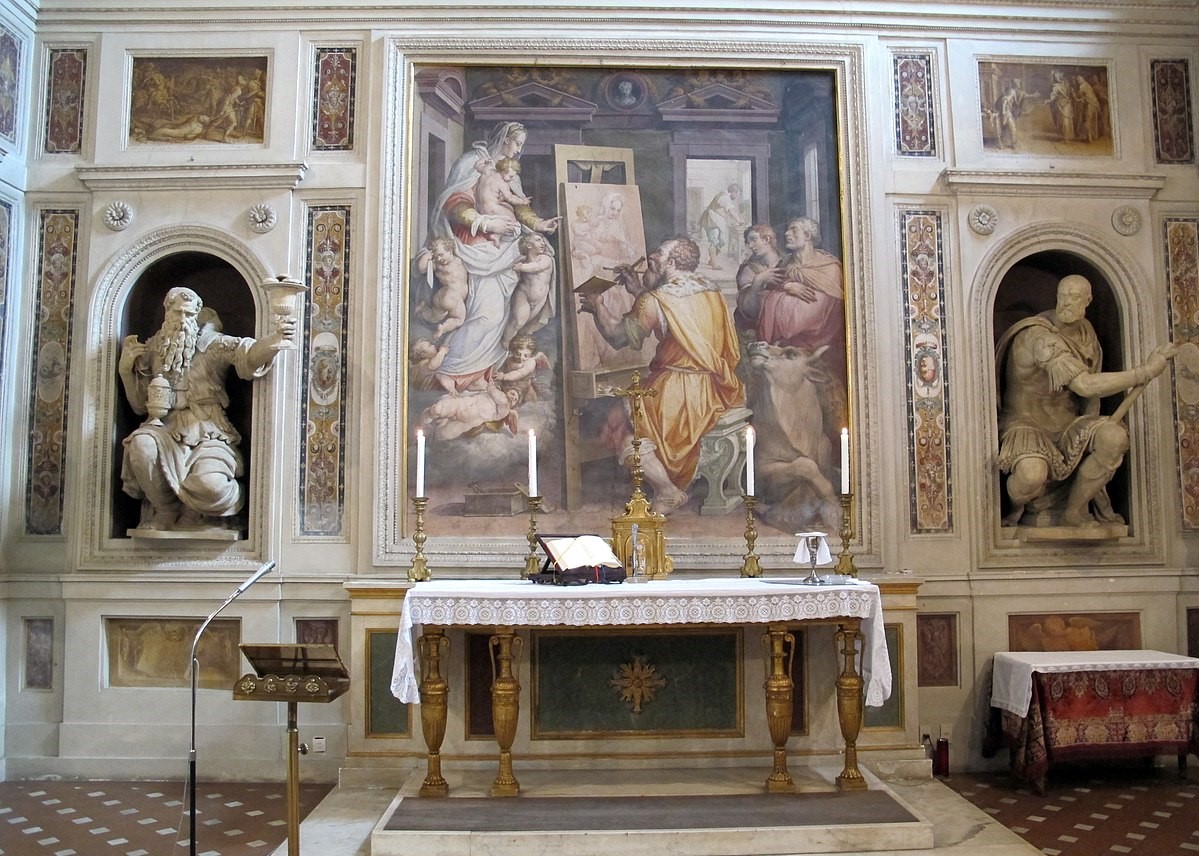
One of the landmarks of Florence's artistic life is returning to its former glory. Set in the jewel of the Convent of the Santissima Annunziata, the Chapel of St. Luca or Cappella dei Pittori (Painters’ chapel) finally regains its original colors and forms thanks to a two-year restoration project.
The imposing frescos by Giorgio Vasari, Santi di Tito and Alessandro Allori, the sumptuous stucco decorations, previously totally altered by posthumous interventions, as well as the large statues made with the rare and precious raw earth technique, the small monochrome frescoes shine again.
Thus one of the most fascinating and least known complexes of the late Florentine Renaissance comes back to life, made unique by the refined mixture of different materials, techniques and hands.
The Chapel of San Luca has been one of the symbolic places of Florentine artistic life since 1565. It was built on the premises of the ancient Chapter of the Convent of the Santissima Annunziata thanks to the dedication and labors of the sculptor friar Giovannangelo Montorsoli, who convinced the Prior General Friar Zaccaria Faldossi first to host and then to donate to the newly founded Academy some of the spaces of the convent.
Two years earlier, in fact, in 1563, the Accademia del Disegno had been born, by Grand Duke Cosimo I and his top collaborators Giorgio Vasari and Vincenzo Borghini, on the ashes of the ancient Compagnia di San Luca (dating back to at least 1339), of which the greatest artists of the Florentine renaissance, such as Leonardo Da Vinci and later Michelangelo Buonarroti, had been members.
Initially named after the Holy Trinity, the Chapel, was the place where the most famous artists gathered to celebrate the association's most solemn oaths and lively academic meetings on the occasion of the Trinitarian feast, of which the three arts painting, sculpture and architecture were mimesis. The feast of Four Crowned Saints patron of Architecture was also celebrated, and finally that of St. Luca, which, by acquired importance, eclipsed all others reconsecrating the Chapel to the Holy Evangelist iconographer of Mary and thus patron of painters.
Masters such as Jacopo Pontormo, whose fresco of the Sacred Conversation detached from the church of San Ruffillo, Benvenuto Cellini and later the 19th-century sculptor Lorenzo Bartolini, as well as Rodolfo Siviero, who was minister plenipotentiary for the recovery of works of art stolen by the Nazis, were buried here.
In addition to restoring the chapel to its original appearance, the long and meticulous restoration of the materials of which the chapel was originally composed has made it possible to highlight precisely the extent and exact location of the two interventions that have most influenced the conservation vicissitudes of this place.
The first, in conjunction with the Napoleonic suppression and the transformation of the chapel for the private use of Bishop Eustachio de Osmond, which involved the closure of the primitive entrance and the displacement of the altar under the Vasari fresco. The second, with the 1966 flood, which caused innumerable damage to the small frescoes of the basement and the lower part of the sculptures, thus re-emerged the original stuccoes, concealed by multiple layers of scialbatura, the delicate lead-white finish present on the statues and the painted terra cruda that characterizes as many as seven works, a uniquely interesting feature we find in Giambologna's sculpture of Charity in the choir of the Basilica of the Santissima Annunziata.
Those who visit it today find themselves face to face with evidence of five centuries of history, but also with tasty curiosities. On the high altar, for example, towers the St. Luca painting the Virgin created by Giorgio Vasari. Setting the scene in a real 16th century painting studio, the artist from Arezzo abandoned all false modesty and attributed his own face to the patron saint of painters.



